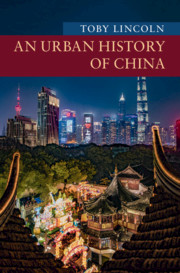Book contents
- An Urban History of China
- New Approaches to Asian History
- An Urban History of China
- Copyright page
- Contents
- Figures
- Maps
- Tables
- Acknowledgements
- Introduction
- 1 The Emergence of China’s Imperial Urban Civilization (Antiquity to 220 CE)
- 2 The Expansion of China’s Imperial Urban Civilization to the South (220–755)
- 3 The Tang-Song Transition and Its Effects on China’s Imperial Urban Civilization (907–1402)
- 4 The Flowering of Chinese Imperial Urban Civilization (1402–1799)
- 5 The Seeds of Urban Modernity (1800–1895)
- 6 Urban Modernity in Republican China (1895–1949)
- 7 The Maoist Period (1949–1976)
- 8 The Reform Era and the Present
- Conclusion
- Index
- Series page
- References
7 - The Maoist Period (1949–1976)
Published online by Cambridge University Press: 29 April 2021
- An Urban History of China
- New Approaches to Asian History
- An Urban History of China
- Copyright page
- Contents
- Figures
- Maps
- Tables
- Acknowledgements
- Introduction
- 1 The Emergence of China’s Imperial Urban Civilization (Antiquity to 220 CE)
- 2 The Expansion of China’s Imperial Urban Civilization to the South (220–755)
- 3 The Tang-Song Transition and Its Effects on China’s Imperial Urban Civilization (907–1402)
- 4 The Flowering of Chinese Imperial Urban Civilization (1402–1799)
- 5 The Seeds of Urban Modernity (1800–1895)
- 6 Urban Modernity in Republican China (1895–1949)
- 7 The Maoist Period (1949–1976)
- 8 The Reform Era and the Present
- Conclusion
- Index
- Series page
- References
Summary
After 1949, the Communist government invested in industrial development, much of it in cities far from the coast, which were now linked to the urban system by rapidly expanding rail and road networks. Industrial development caused rural-to-urban migration, and so the government introduced policies to keep people in the countryside, which meant that there were few really large cities in the Maoist period. Influenced by the USSR, Chinese planners built micro-districts combining work with housing and municipal services. Most were managed by danwei (work units), such as large state-owned companies, where Communist Party cadres organized many aspects of urban life. Urban space was now highly politicized, and this allowed the government to mobilize the people during political campaigns. Communist Party cadres became a new urban elite, and there were divisions between those who worked for large state-owned enterprises, and had access to urban amenities through their danwei, and those who worked in smaller factories or workshops. Meanwhile, people’s class status became important in their daily lives. Those who were from bourgeois backgrounds were targeted in political campaigns, and during the Cultural Revolution many suffered humiliating struggle sessions at the hands of Red Guards.
- Type
- Chapter
- Information
- An Urban History of China , pp. 191 - 222Publisher: Cambridge University PressPrint publication year: 2021

